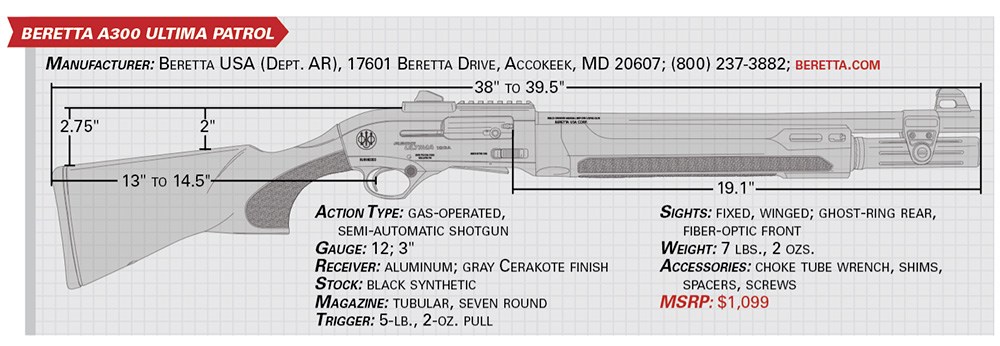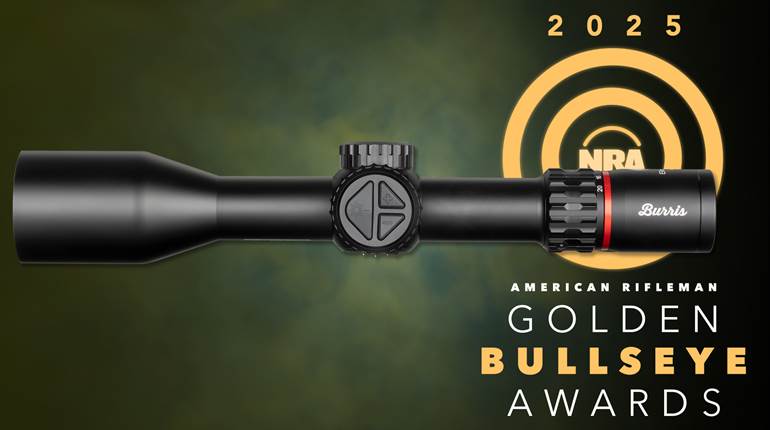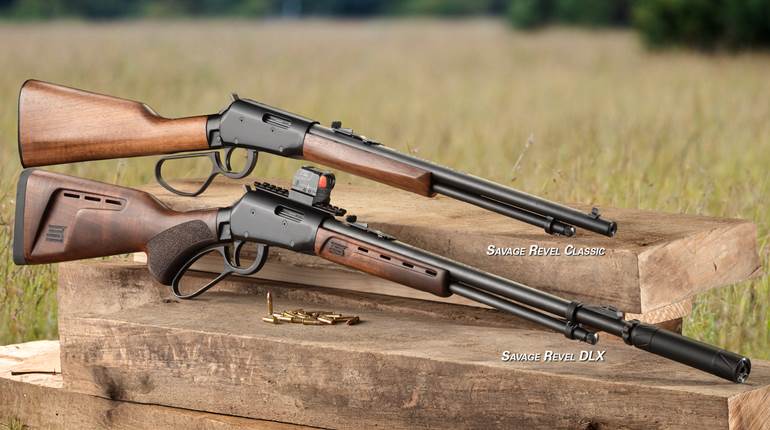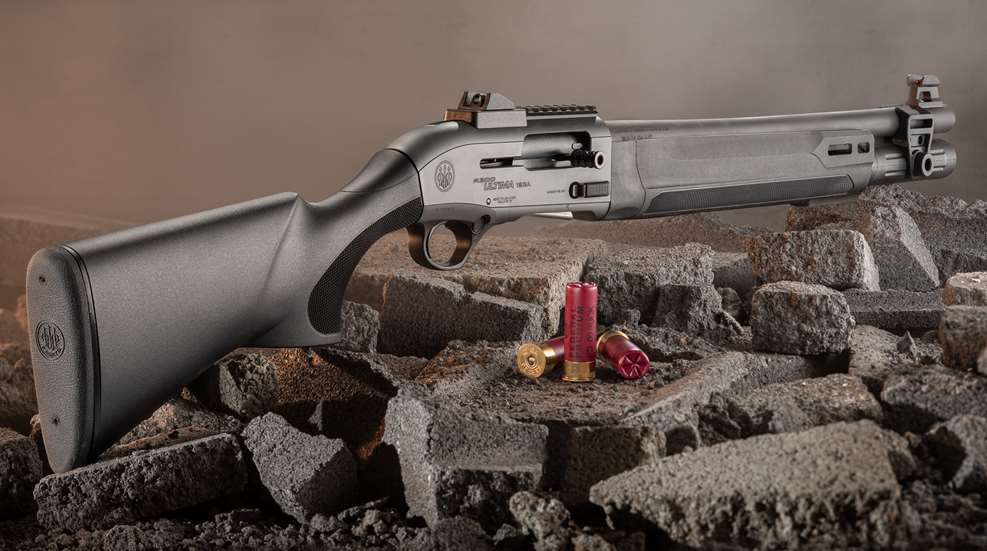
In the realm of firearms, there are often opportunities for crossover because feature sets or characteristics of a particular gun may be equally applicable to multiple pursuits. For instance, in rifles, the ubiquitous modern sporting rifle (MSR), and AR-pattern rifles in particular—depending on the configuration and chambering, of course—can be used for home/self-defense, hunting and competition. This multi-purpose philosophy applies to shotguns, too. An over-under or semi-automatic shotgun perfect for clays competition can pull double-duty for upland and waterfowl hunting, and a scattergun optimized for law enforcement is often ideal for 3 Gun competition and/or home-defense.
With that in mind, among Beretta’s newest shotguns is the 12-ga. A300 Ultima Patrol, a model that, despite its moniker, is at home anywhere immediate access to above-standard ammunition capacity is needed, all in a reliable, compact and highly maneuverable platform.
Origins
Unless you’re new to firearms—and, in that case, welcome—you’re probably well aware that firearm maker Fabbrica d’Armi Pietro Beretta S.p.A. of Gardone Val Trompia, Italy, is the world’s oldest active gunmaker. Beginning with the 1526 sale of 185 arquebus barrels to the Arsenal of Venice by Maestro Bartolomeo Beretta, the company has continually manufactured arms for the past 497 years. There are no signs of slowing, either. Obviously, the company’s offerings have changed significantly in the past half-millennium (after all, who currently needs an arquebus barrel?), but the same commitment to quality that established its reputation remains integral to the brand.
In recent times, Beretta has offered consumers rifles and carbines, such as the ARX 100 and 160, as well as the Cx4 Storm, and in handguns there have been the 92, APX and Px4 series, to name only a few. But, for many, the company is likely best recognized for its extensive line of reliable, rugged, premium-quality shotguns. Why? Because they work well—very well.
As such, you’re likely to encounter them in an array of environs ranging from marshes and goose pits to CRP fields and clays courses (i.e. sporting clays, FITASC, skeet, wobble, trap, etc.) from the local to the Olympic level. Concerning the latter, you’ll see a disproportionately high percentage of Beretta over-under and semi-automatic shotguns in the hands of participants and winners. For instance, as reported on by The Outdoor Wire on May 2, 2023, “Team Beretta athletes achieved three podium titles at the recent 2023 Texas State Sporting Clays Championship in San Antonio.” There’s a reason why “B” guns are recommended for serious competition and why top-tier shooters such as Anthony Matarese, Jr., Vincent Hancock, Kim Rhode, Joseph Fanizzi and others use them.
Focusing specifically on its semi-automatic offerings, Beretta has two lines: the Italian-made A400 and the American-made A300, which debuted in 2021. The Ultima Patrol is within the A300 series, and we’ll focus on it here. As with other models in the A300 line, the Ultima Patrol is manufactured in Beretta’s sprawling Gallatin, Tenn., facility. As an aside, other arms built there include the Tomcat and Bobcat tip-barrel and Model 92 pistols. Currently, there are more than a dozen shotguns in the A300 series, with three of them being Ultima Patrol variants. Separately, some A300 Outlander shotguns have been relegated to “legacy” status or, in other words, retirement.
Making its debut at the Shooting, Hunting and Outdoor Trade (SHOT) Show in early 2023, the 12-ga. A300 Ultima Patrol was created with law enforcement and home/self-defense in mind; however, the company prudently tapped the knowledge and experience of Team Beretta in designing it. For instance, it worked with Jessica Hook, whose website lists her as a lady’s champion in 3 Gun, PCC (Pistol Caliber Carbine) and Rifle/Carbine.
According to Logan Killam, Beretta’s shotgun product manager, “Jessica’s suggestions and her modified gun were the inspiration for the loading port. We also worked with Rob and Matt Haught of Symtac for help on the fore-end texture and designs.” Symtac Consulting, Inc., is a firearm-training organization with multiple shotgun courses in addition to those for handgun, rifle (including safari prep), carbine, low-light, etc. Given the attention to detail from LE (Haught) and competition (Hook) shooters, the A300 Ultima Patrol is well-suited for both uses.
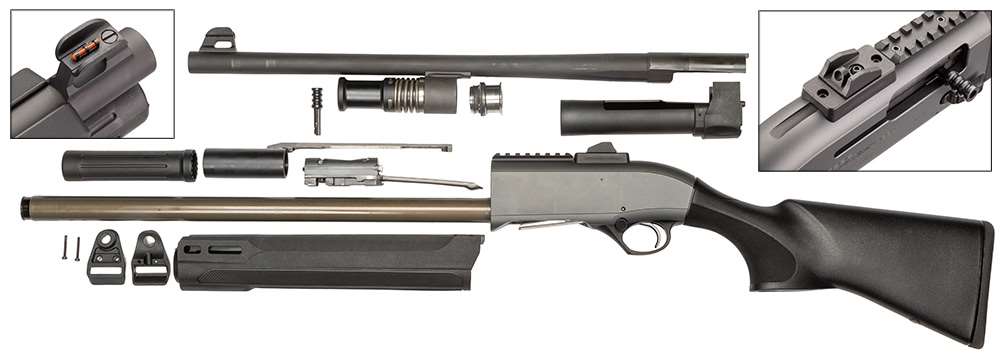
Design Details
The A300 Ultima Patrol, like the company’s other semi-automatics, has a receiver CNC-machined from 7075-T6 aluminum. Since lockup occurs in the steel barrel extension, rather than the receiver itself, the use of aluminum saves weight and diminishes concerns about corrosion. Moreover, Beretta uses an anodic oxidation process that further protects the firearm from corrosion and scratching. The A300 Ultima Patrol is currently offered in three colors: black; gray (tested); and tiger stripe. While the black and gray variants are $1,099, tiger stripe will set you back an extra $100.
The left side of the shotgun’s low-profile receiver is machined smooth. Why? Included is a strip of Velcro for adding accessories. The right side, however, is where you’ll find the Beretta logo, “A300 Ultima 12 GA,” the serial number and other pertinent information, presented in a tasteful way. It’s here that you’ll begin to notice some of the Ultima Patrol’s standout features. For example, there’s an extended, oversize cylindrical cocking handle with three annular grooves for maximum purchase, as well as a lengthy breechbolt release button with a polymer covering. The latter measures 1.110" in length and requires minimal pressure to operate.
Beneath the receiver is Hook’s contribution to the A300 Ultima Patrol; between the enlarged opening and angled sides, as well as the shallow channel on the bottom of the carrier, feeding shells into the tubular magazine is extraordinarily fast, easy and utterly failproof. Whether for defense or competition, loading time is critical, and this feature is designed to reduce the time needed to bring the shotgun back to full capacity.

The top of the Patrol’s receiver has the sighting groove employed on sporting and hunting models, but it’s unusable as shipped from the factory; drilling and tapping the receiver has enabled the company to add a modular ghost-ring sight. Made from plastic, the base is secured to the shotgun via two screws, and the sighting portion is affixed to the base—which has a threaded brass insert—via a single screw. The winged ghost-ring (or peep) opening is 0.225" in diameter. The sight is not adjustable for windage or elevation. “It [plastic] was used for two reasons,” Killam said. “First, plastic is lighter and less costly and helped us get down below the $1,000 price in the market—(the MSRP is $1,099). Second, the metal sight is not much stronger than the plastic but is heavier and more costly.” Forward of the abovementioned sight is a seven-slot strip of 1913 Picatinny rail.
Most of the fire controls are contained within the trigger assembly, which is affixed to the receiver via a single pin. Included are the push-button carrier stop, which is at the rear of the loading port, a two-position, oversize crossbolt safety that is reversible, and a single-stage trigger. On the sample gun, the trigger broke at an average of 5 lbs., 2 ozs.; there was a hint of creep, but the pull was smooth. Largely, it was a very good trigger for a semi-automatic shotgun. The trigger guard is sized to accommodate even a large, gloved finger.
Made via drilling and reaming, the A300 Ultima Patrol’s 19.1" barrel has a standard forcing cone and is threaded to accept the ubiquitous Beretta Mobil-pattern choke tubes. A single flush-fitting, improved cylinder choke tube accompanies the gun. Frankly, given its purpose, that’s all that is needed. According to Killam, the entire barrel is chrome-plated, not just the bore. The rib-less barrel ends with a raised, fixed front sight consisting of a non-illuminated orange pipe with wings (a separate piece) on both sides.
The barrel is secured to a cover, or cap, atop the extended, tubular magazine—providing 7+1 capacity—via a polymer M-Lok barrel clamp. Not only does the clamp provide mounting options for accessories, but it also has several QD sling-mounting points. In total, the gun has three. With the barrel clamp removed, the polymer cover can be unscrewed and detached, thus permitting the larger front portion of the fore-end to be slid off. Only then can the barrel be removed and the gas system accessed.

Operation of the A300 Ultima Patrol’s gas system is typical, but it still bears mentioning here. Upon firing, propellant gases bled from the barrel through dual ports enter into the cylinder and interact with the piston, which then impinges on the cylindrical portion of the operating rod assembly—itself connected to the bolt assembly. Doing so disengages the locking lug, freeing the bolt assembly to travel rearward. During this process, the hull is extracted from the chamber and expelled via a spring-loaded ejector on the left receiver wall. The recoil spring in the buttstock, then compressed, rebounds, where the forward-moving bolt assembly collects a shotshell from the carrier and chambers it. Lockup is completed as the bolt returns into battery.
The online owner’s manual states, “The patented gas-operated system with self-cleaning cylinder and piston, has a compensating exhaust valve so that excess pressure caused by the most powerful cartridges can be decreased automatically. As a result, the shotgun, without any adjustment or intervention, can shoot cartridges from 2¾" (7/8 oz.) to 3" (2 oz.).” “Some of the ‘low-recoil’ ammunition will not always cycle the actions, but most will,” Killam added. “We try and tune the mechanism around the types of most common loads. So, the A300 Patrol is tuned for Federal LE132 and so on.”
Gas-operated shotguns, in general, are dirtier than their inertia-operated counterparts due to the fact that, when gases are vented for functioning, so, too, does residue and debris exit the barrel ports. To counteract this, Beretta designed the A300’s gas system to be self-cleaning. Beretta states, “The piston is designed to constantly clean out gunpowder residue in the cylinder, increasing the efficiency of the firearm and reducing the need for frequent maintenance. The elastic piston seal has a rough finish to optimize cleaning.” Moreover, Killam shared, “The self-cleaning gas system is self-cleaning because, as carbon and other fouling builds up, the system breaks the deposits away as the next round is fired. You can think of it as kicking the mud flap on your truck after you have been driving in the snow.” The debris will be discarded out the fore-end. The system works well but is by no means a reason for disregarding routine cleaning/maintenance of your gun—especially anything meant for self-defense or competition. Cleaning every 500 rounds or so would be prudent.
As mentioned elsewhere, the fore-end design and finish were the brainchild of Rob and Matt Haught. The forwardmost section of the synthetic handguard is where the detail is focused; the rear section serves as a fore-end adapter/piston stop. First, the fore-end is thin, measuring 1.815" at its widest and slimming to about 1.230" near the top. Moreover, there are three lengthy panels of aggressive, abrasive integral checkering spanning nearly the full length of the bottom and sides. Between the texture and dimensions, firm purchase is assured. Near the front, on the sides and bottom are multiple M-Lok slots for adding accessories.
The buttstock is made of the same material and continues the theme of maximum purchase. Instead of the customary practice of adding checkering to each side of the pistol grip, on the A300 Ultima Patrol, it runs uninterrupted from the bottom half of one side to the same location on the other. The addition of texturing underneath the pistol grip shouldn’t be dismissed lightly—it really aids control of the shotgun.
The Patrol was designed to have a short, 13" length of pull, making it more maneuverable in small spaces. However, that could be too small for some. For a custom fit, included with the gun are shims and spacers for adjusting drop, cast and length of pull. Capping the buttstock is a 1/2"-thick recoil pad. Although somewhat pliable, it does little to reduce felt recoil. Being slightly tacky, it does tend to snag on clothing when shouldering the gun, but it also means the gun tends to stay put once shouldered.
At The Range
Testing of the A300 Ultima Patrol occurred in multiple phases, beginning with patterning. Given the intended purposes of the shotgun, I opted to pattern it using the supplied flush-fitting, improved-cylinder choke and Federal’s Personal Defense NRA 12-ga., 2¾" load—featuring nine pellets of copper-plated 00 buck at 1,145 f.p.s.—from a Browning sandbag rest at 25 yards. Ten consecutive shots were tallied.
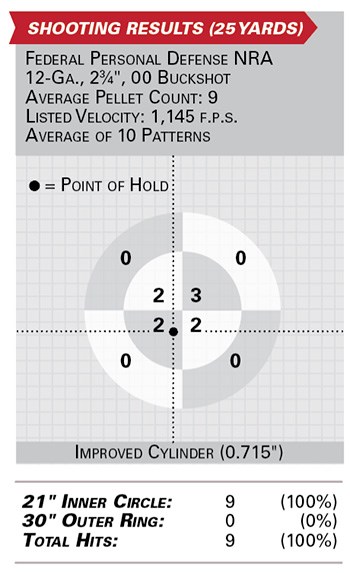 The full results are illustrated in the accompanying table, however, several things deserve elaboration. First, the gun patterned extremely tightly at the test distance, despite using a lightly constricted choke. Why? The selected load featured Federal’s renowned FLITECONTROL wad, which significantly tightens patterns—almost too much so within the confines of someone’s abode. At 25 yards, all of the patterns easily fell within the target’s 21" inner circle; in fact, the pellet distribution of most patterns measured 12" or less—sometimes significantly so.
The full results are illustrated in the accompanying table, however, several things deserve elaboration. First, the gun patterned extremely tightly at the test distance, despite using a lightly constricted choke. Why? The selected load featured Federal’s renowned FLITECONTROL wad, which significantly tightens patterns—almost too much so within the confines of someone’s abode. At 25 yards, all of the patterns easily fell within the target’s 21" inner circle; in fact, the pellet distribution of most patterns measured 12" or less—sometimes significantly so.
Next, when using the supplied “iron” sights, the shotgun consistently patterned about 4" to 5" high and about half that to the right. Unfortunately, there is no practical way to adjust them. Of course, a different rear sight, or taking advantage of the Picatinny rail, would overcome this issue. This would also alleviate the less-than-optimal drabness of the front sight, which can be difficult and slow to acquire. A better front sight would be one of my few suggestions for improvement.
With patterning done, I set about testing the reliability of the sample. Given the significant fouling remaining in the shotgun I received for testing, I can only surmise how many rounds had already been run through it, and I was about to add a lot more. Taking into account the recommended ammunition for all-out reliability, I assembled a smorgasbord of handloads and factory ammunition, beginning with 2¾", 3/4-oz. handloads. Yes, you read that correctly. Using the Claybuster CB0175-12 wad, Alliant Clay Dot propellant, Federal Gold Medal hulls and Fed 209A primers, the 328-grain load attains 1,300 f.p.s.—and the A300 Ultima Patrol cycled them flawlessly. As it did with the Fiocchi Shooting Dynamics 7/8-oz. shells at 1,350 f.p.s., BioAmmo with 7/8 oz. of steel shot at 1,325 f.p.s., and 1-oz. Winchester Super Target Xtra-Lite at a modest 1,180 f.p.s. Next, I went to Federal Upland Steel, which propelled 1 1⁄8 ozs. of shot to 1,400 f.p.s., then transitioned to Winchester Rooster XR with 1¼ oz. of copper-plated lead shot attaining 1,300 f.p.s. Not one hiccup. From there, I tried handloaded 2¾", 1 3⁄8-oz. No. 2s at 1,250 f.p.s., followed by 3", 1 3⁄8-oz. Kent Fasteel loads. Nothing I tried resulted in a failure to function. As such, I began shooting them in random order, and even with a few cosmetically imperfect reloads sprinkled in. Still, the Beretta cycled perfectly—it is reliable, for sure.

While burning through box after box of shells, it became apparent that the shotgun’s recoil was especially noticeable—even with somewhat ballistically unimpressive loads—if proper technique is not practiced. This may have been exacerbated by the minimalist recoil pad, short length of pull and/or light weight. After all, it’s a 7-lb., 2-oz., 3"-chambered 12 gauge! The smartly designed fore-end, especially its aggressive texturing, was welcome, providing me full control of the gun during rapid-fire drills—although it was quite abrasive given the recoil.
Despite not having a bright front sight, Beretta more than made up for it with the ghost-ring rear. With minimal practice, target acquisition was immediate and, as the accompanying patterning results illustrate, the results were devastating for the target. As such, it’d be a perfect for personal protection.
Although dubbed the “A300 Ultima Patrol,” this shotgun is the perfect crossover model. Need something to protect against four-legged camp marauders or aggressive bruins on the stream? What about home defense or 3 Gun? You’ll be covered. On the range, the shotgun proved that it’s rugged and reliable with quite the variety of ammunition.
Then again, that’s what can be expected from an Italian shotgun manufacturer in business since 1526 that has it built by American craftsmen in the southeast.
